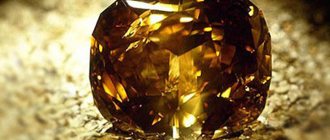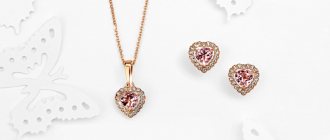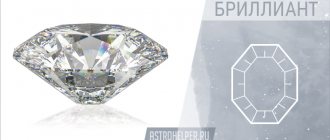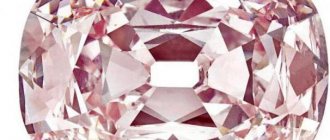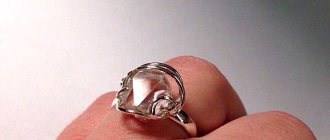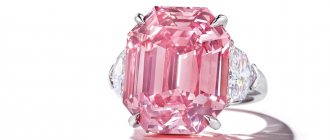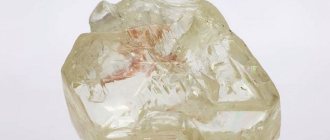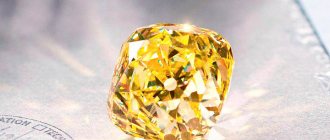These diamonds may cost less in the market, but some in the trade say there is no reason for this and are taking advantage of the opportunities these stones present.
Fluorescence is not included in the 4Cs. However, this has not stopped it from becoming an important element when it comes to haggling over the price of diamonds. In the grading world, fluorescence refers to “the visible light that some diamonds emit when exposed to ultraviolet rays,” as defined by the Gemological Institute of America (GIA). Most often the light is blue, but sometimes it can be white or yellow.
“The first thing you do when you pick up a parcel of diamonds is put it under a fluorescent lamp to see how fluorescent it is,” admits Satta Matturi, founder of rough diamond buying service Ideal Luminescence.
While GIA research shows that in the vast majority of cases, fluorescence has no noticeable effect on a diamond's appearance, "diamantaires generally look down on fluorescence," believing it to detract from the stone's value, said Eddie Levian, chief executive of US jewelry company Le Vian.
Indeed, most buyers in the industry have seized on this feature of diamonds as an opportunity to obtain lower prices. The Rapaport price list has a section dedicated to the discounts you can expect when purchasing blue fluorescent diamonds. Depending on the color and clarity of the stone, the discount can be up to 25% if the fluorescence is very strong, or 1% if it is weak.
Why do diamonds fluoresce under UV light?
The ability of diamonds to luminesce when exposed to ultraviolet light is caused by two factors:
- defects in the diamond crystal lattice;
- the presence of impurities in the structure of the stone - chemical substances with incomplete electron shells of atoms (the so-called luminogen elements).
However, if we answer the question of whether diamonds glow in ultraviolet light, it should be noted that the purest (highest quality) diamonds do not fluoresce in UV rays, which is due to the uniformity of their composition and the absence of defects at the molecular level.
A win for the thrifty
“The public perception of fluorescence is, in my opinion, very flawed,” says Mo Hanzi, managing director of jewelry company Pugata, who blames the Internet for causing confusion. But by explaining the reality of fluorescence, Pugata has been able to convince buyers to switch to other types of diamonds, which could mean that "a customer who couldn't afford a carat can suddenly afford a carat," Hanzi says. “The market was forced to sell stones with fluorescence at a lower price. In this case, those who understand this win, and they will receive a lower price for the exact same stone.”
Fluorescence and luminescence of diamonds
If we do not take into account pure diamonds, for which fluorescence is not characteristic, depending on various factors, for example, the level of transparency of the mineral, the conditions of its formation, the presence of inclusions of certain substances and other conditions, diamonds can fluoresce in different ways: from the most common pale blue (transparent stones) to green and yellow (opaque brown diamonds).
The color group of fluorescent diamonds is determined by the primary color observed when the mineral is exposed to UV rays. In world practice, fluorescence is divided into four categories: from zero to strong. In addition, some diamonds can stand out in a separate group with a very strong glow.
An interesting fact is that the fluorescence of diamonds has a completely different effect on their value in different markets around the world. So, if in the countries of North America stones that glow in UV light are more expensive, then in Europe everything is exactly the opposite. As for the domestic market, fluorescence has virtually no effect on the cost of both the stones themselves and jewelry with them.
The second interesting fact is that diamonds continue to glow even after the ultraviolet light source is turned off. Thanks to this effect, you can distinguish a fake from a real or synthetic stone.
Why do they have such bad reviews?
Despite the negative sentiment, there is little scientific evidence to support claims that fluorescent diamonds are inferior stones. Fluorescence is a common phenomenon, occurring in somewhere between 25-35% of all diamonds, according to the GIA. Only 10% of them are classified as "moderate," "strong" or "very strong" fluorescence—levels that the lab says "may affect appearance."
One of the biggest—and popular—criticisms is that fluorescence can give diamonds a milky appearance. However, GIA reports that less than 0.2% of the fluorescent diamonds it received for testing had a "cloudy or oily" appearance as a result of the fluorescence, so this phenomenon is incredibly rare.
“There is a belief that fluorescence affects the value of a diamond, and I think that is probably true,” says gemologist and dealer Eric Emms. “Whether this is fair or not is a moot point.”
While Emms says the negative review is largely a trade issue, the malignment of these stones may have started with a lack of knowledge among consumers. “There are stories from the past where customers would buy a diamond ring, go to a disco [where ultraviolet lights detect fluorescence] and bring it back complaining that one of the diamonds was blue, so, 'It can't be a real diamond, can it?' , Mr. Jeweler?,” says Emms. “This is one of the reasons why fluorescence is thought of in a negative way. Wholesalers don't want to explain this phenomenon to the public."
Checking diamonds for authenticity
How to easily distinguish a real diamond from a synthetic one or cubic zirconia/glass can be seen in the video below.
In a nutshell, natural diamonds continue to glow on their own for quite a long time after the ultraviolet flashlight is turned off.
In order to see the glow of a diamond in UV rays, an ultraviolet flashlight or lamp with a wavelength of 365 nanometers or 395 nanometers is suitable, but always with a black filter! The second option works better, but is also more expensive. At the same time, when choosing a homologous UV flashlight, it is worth remembering that the higher the power of the UV flashlight, the higher its efficiency.
In general, ultraviolet light can be used to search for precious stones, as well as by pawnshop employees, diamond sorters, appraisers, sellers, and other specialists whose professional activities are related to diamonds.
Glowing Jewels
One buyer benefiting from this situation is Kostan Yeghiazaryan, managing partner of the Austrian jewelry brand Aenea. It collects D-color diamonds from 3.50 carats and above with very strong fluorescence (VST). “I love the effect,” says Yeghiazaryan, who enjoys watching the color emerge from these stones when sunlight hits them.
British jewelry designer Cora Sheibani feels the same way. Her Glow collection not only celebrates fluorescence, but also celebrates it: clients are invited to view the fluorescent gemstones she has chosen for her jewelry—like the aptly named Disco ring—under an ultraviolet light and admire the color change. In addition to diamonds, Sheibani uses colored gemstones that fluoresce, such as spinel, ruby and tourmaline.
Gold Highlighter Bracelet with Fluorescent Diamonds by Cora Sheibani:
What is the difference between a diamond and a brilliant
People often confuse the concepts of diamonds and rough diamonds. Let's figure out how they differ. Diamond is a natural nugget, which is essentially a type of graphite. In its original form, the mineral has an unsightly cloudy appearance, reminiscent of ordinary mica. The main distinguishing feature of a gemstone is its strength. Once a jeweler processes a clear diamond and gives it the appearance that everyone is used to seeing in precious jewelry, it becomes a diamond. In other words, a diamond is a processed diamond. But what specific actions does the master take to create these incredibly mesmerizing precious gems? Let's look at them in more detail:
- During the first inspection, the jeweler examines the internal structure of the white stone. Even the most microscopic inclusion during the work process can split a future diamond. Therefore, before planning the shape and approximate size of the gem, you need to make sure of its internal perfection. If the original stone has a matte surface, it must be polished so that the internal structure can be assessed.
- Next, using a magnifying glass, you need to identify external defects - chips, scratches, growths. These areas will be subject to particularly careful processing, as a result of which the shape of the finished product may change.
- After studying the surface and internal structure of the stone, the master begins the first stage - splitting. All internal deformations found must be removed to avoid future problems. This is why original stones are always much larger than processed diamonds. The splitting is done very slowly and carefully so as not to injure intact areas. Sometimes a 1 carat stone takes up to 8 hours to cut.
- Then you should proceed directly to cutting. After the jeweler has outlined the appearance of the future transparent gem, he begins to create edges and carefully polish them. Given the high strength, such work is carried out exclusively with the help of another diamond, or rather diamond chips. Each edge angle and direction is controlled manually by the cutter.
As can be seen from the description, for high-quality jewelry, not only the original stone is important - its size, purity and integrity, but also the hands of the master. Without many years of experience and talent, you will never be able to create valuable jewelry.
How to distinguish cubic zirconia from a fake?
If possible, it is worth looking through the stone. A diamond will not allow you to see the light, you will notice a luminous point, whereas cubic zirconia
passes it well.
You can do a simple test. You need to put paper with printed text, if it can be read through the stone, then you are holding cubic zirconia
.
Interesting materials:
Where is the average number of employees submitted? Where to submit information about the average number of employees? Where can I complain about public transport? Menchaydazer work, what is it? What is installation work? Is it possible to paint the facade with interior paint? Is it possible to hire workers for an individual entrepreneur? Is it possible not to go to work in the cold? Is it possible to work two jobs at the same time? Is it possible to officially work two jobs at the same time?
Jewelry News
In the markets of America, Europe, and Asia, buyers show aversion to stones whose certificates contain a mark indicating the presence of fluorescence. This attitude is difficult to explain, much less justify. It may have been inspired by the reaction of nightclub patrons who claim that their diamond jewelry changes color when exposed to the club's blue light.
Amnon Amoyal, CGI
For inexplicable reasons, the market does not take kindly to gemstones that have a fluorescent mark on their certificate. This rejection causes significant damage to everyone - both diamond producers and traders.
Before delving into the issues of fluorescence, let's make a short excursion into history. Before World War II, the member countries of a European jewelers' association called BIBOA (International Bureau of Jewelry, Gold and Silver) attempted to formulate a unified international system for grading and documenting diamonds and other precious stones. The founders of the association were convinced that this would promote fair trade in precious stones.
In 1960, the International Confederation of the Jewelery Industry (CIBJO) was created. It united jewelers, diamantaires and dealers in precious stones and pearls under its wing, replacing BIBOA. A year later, the CIBJO plenum was held, at which the official establishment of the organization was announced. At the same plenum, Israel joined the confederation.
In 1979, at one of the CIBJO meetings on the nomenclature of diamonds and other precious stones, the conversation naturally turned to photoluminescence, also known as fluorescence.
Representatives of the Federal Republic of Germany insisted that a perfect diamond must consist of pure carbon without any foreign inclusions or impurities, and that diamonds that do not meet this criterion cannot be considered perfect.
In their opinion, the luminescent glow (fluorescence) observed in a diamond under the influence of short and long wavelengths of ultraviolet radiation would serve as an effective scientific method for determining the composition of diamonds and other precious stones, as well as their purity.
This approach was due to the high level of consumer awareness regarding the purity of the stone and the absence or presence of impurities in it. At that time, the vast majority of buyers were representatives of the bourgeois elite and members of European royal families, who accepted only perfection. “Situation obliges,” they said, and therefore if a Frenchman, Englishman or German was going to present his beloved with a diamond, the stone certainly had to be perfect.
Gemological institutes, in turn, began to use ultraviolet emitters when conducting photoluminescence tests, which, by the way, were used exclusively in science and medicine at that time.
The institutes participating in CIBJO at that time seriously believed that they could include in the certificates whatever data they wanted about the quality of the stone, including cut quality and even price. Manufacturers of diamonds and other gemstones have said that while the proposal is intriguing, if this is what the institutes plan to do, and if they are going to use ultraviolet light testing to assess clarity, they are unlikely to get a single stone certified.
The Americans were of the opinion that it was necessary to concentrate on creating a glossary in which all natural gemstones, diamonds and imitation gemstones would be described in detail and categorized, and there was no point in delving into scientific studies of the morphological structure of gemstones.
They argued that the clarity of a diamond should be determined using binoculars or a magnifying glass with a magnification of no more than ten times.
It was decided that ultraviolet radiation testing would be used for auxiliary purposes when it is necessary to determine the origin of a stone or to double-check certificate data. This practice is still relevant today.
Accordingly, the problem of fluorescence testing did not arise from gemological certification as such, but from the overemphasis placed on this parameter.
Fluorescence
What is fluorescence? Fluorescence is the direct emission of light by a molecule. For this to happen, the molecule must have an excess of energy compared to its normal state. This excess appears due to external influence.
Almost all minerals, including diamonds, react to ultraviolet light by emitting fluorescent radiation, ranging in color from bluish to deep blue or yellow to red. About 40 to 60 percent of diamonds will fluoresce when exposed to ultraviolet wavelengths longer than 366 nanometers. For some diamonds, it will be observed in short-wave ultraviolet light with a wavelength of 254 nm.
When a diamond's fluorescence has a bluish tint, regardless of the stone's clarity, it can hide any yellowish undertones in the stone's color. Similarly, the yellow tint of photographs can be removed by adding blue color during development.
Some defects, such as molecular clouds, are not detected by optical equipment. These clouds may represent areas of broken crystal structure, metal impurities, or other defects. In ultraviolet light they look like milky or oily spots. To the naked eye, the stone may appear to have slightly changed color. This phenomenon, however, can only be observed under the influence of ultraviolet radiation.
Americans, especially the Gemological Institute of America (GIA), have been arguing for many years that fluorescence is an advantage for diamonds with yellowish hues, except for those that contain molecular clouds.
On the European and American markets, stones with certificates indicating fluorescence as “strong” are not in demand among consumers for inexplicable and unjustified reasons. (Fluorescence scale: none, slight, weak, slight, significant, strong, and extremely strong).
Correcting Misconceptions
In the Hong Kong market, buyers are against even weak fluorescence in stones with a good color group. The Chinese market tolerates minor fluorescence, but no longer tolerates minor fluorescence.
The market reaction is reflected in price lists (for example, the Rapaport price list) in the form of “above average” and “below average” indicators. In the price list itself, the presence or absence of fluorescence is not shown in any way, but the presence of strong fluorescence affects when negotiating a price that becomes lower than the list price. Weak fluorescence, as a rule, is not reflected in the price.
To summarize, the market perceives the presence of fluorescence as a disadvantage for stones of the D, E and F color groups and, conversely, as an advantage for the I, J and K color groups.
Perhaps this aversion to fluorescence is due to the fact that nightlife enthusiasts claim that their diamond jewelry changes color in the blue light of a nightclub. You need to understand, however, that a nightclub is not a laboratory, and blue light is not ultraviolet radiation. This is ordinary light, like red, yellow or any other. And it can certainly influence the perception of the color of a diamond in the same way as the perception of, for example, the color of clothing.
There are rare cases when diamonds become phosphorescent. This is easy to recognize because such diamonds continue to glow for at least a few seconds after the exposure to ultraviolet light ceases. As far as we know, the phosphorescent glow is harmless.
From all of the above, it is clearly seen that the market’s attitude towards certain categories of fluorescence specified in certificates causes serious damage to diamond manufacturers and trading organizations.
In the next issue of HaYahalom magazine we will talk about new, incredibly complex equipment, whose dry measurement results leave no room for a creative, emotional perception of the stone and thus do not allow us to fully enjoy the sparkling beauty of a diamond.
Hyper-technologies take away dignity, uniqueness and prestige from the profession. There is an opinion that the diamond industry should not use the full range of grading services from gemological institutes and that their certification should be limited to highly technical data such as percentages and degrees of angles, and not claim to be the final authority in the field of grading and grading.
This article was first published in English and Hebrew in issue 198 of HaYahalom magazine. https://smartpage.co.il/vault/mag/hyalom_eng.html
